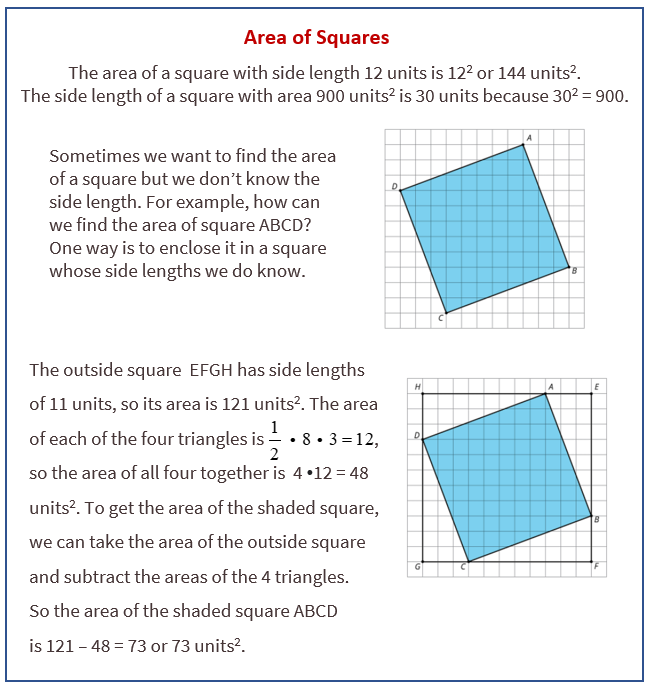Illustrative Mathematics Grade 8, Unit 8, Lesson 1: The Areas of Squares and Their Side Lengths
Learning Targets:
- I can find the area of a tilted square on a grid by using methods like “decompose and rearrange” and “surround and subtract.”
- I can find the area of a triangle.
Related Pages
Illustrative Math
Grade 8
Lesson 1: The Areas of Squares and Their Side Lengths
Let’s investigate the squares and their side lengths.
Illustrative Math Unit 8.8, Lesson 1 (printable worksheets)
Lesson 1 Summary
The following diagram shows how we may find the area of a square but we don’t know the side lengths.

Lesson 1.1 Two Regions
Which shaded region is larger? Explain your reasoning.
Lesson 1.2 Decomposing to Find Area
Find the area of each shaded square (in square units).
Are you ready for more?
Any triangle with a base of 13 and a height of 5 has an area of 65/2.
Both shapes in the figure have been partitioned into the same four pieces. Find the area of each of the piece and verify the corresponding parts are the same in each picture. There appears to be one extra unit of area in the right figure than in the left one. If all of the pieces have the same area, how is this possible?
Lesson 1.3 Estimating Side Lengths from Areas
- What is the side length of square A? What is its area?
- What is the side length of square C? What is its area?
- What is the area of square B? What is its side length? (Use tracing paper to check your answer to this.)
- Find the areas of squares D, E, and F. Which of these squares must have a side length that is greater than 5 but less than 6? Explain how you know.
Lesson 1.4 Making Squares
Use the applet to determine the total area of the five shapes, D, E, F, G, and H. Assume each small square is equal to 1 square unit.
Open Applet
Lesson 1 Practice Problems
- Find the area of each square. Each grid square represents 1 square unit.
- Find the length of a side of a square if its area is:
a. 81 square inches
b. 4/25 cm2
c. 0.49 square units
d. m2 square units - Find the area of a square if its side length is:
a. 3 inches
b. 7 units
c. 100 cm
d. 40 inches
e. x units - Evaluate (3.1 × 104) · (2 × 106). Choose the correct answer:
- Noah reads the problem, “Evaluate each expression, giving the answer in scientific notation.” The first problem part is: 5.4 × 105 + 2.3 × 104. Noah says, “I can rewrite 5.4 × 105 as 54 × 104. Now I can add the numbers: 54 × 104 + 2.3 × 104.” Do you agree with Noah’s solution to the problem? Explain your reasoning.
- Select all the expressions that are equivalent to 38.
The Open Up Resources math curriculum is free to download from the Open Up Resources website and is also available from Illustrative Mathematics.
Try the free Mathway calculator and
problem solver below to practice various math topics. Try the given examples, or type in your own
problem and check your answer with the step-by-step explanations.

We welcome your feedback, comments and questions about this site or page. Please submit your feedback or enquiries via our Feedback page.